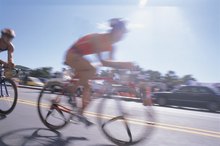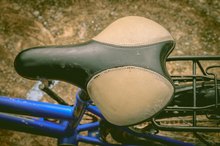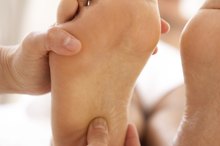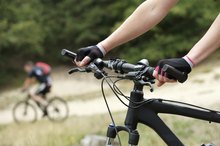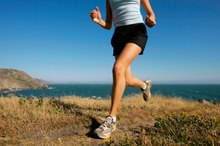What does fact checked mean?
At Healthfully, we strive to deliver objective content that is accurate and up-to-date. Our team periodically reviews articles in order to ensure content quality. The sources cited below consist of evidence from peer-reviewed journals, prominent medical organizations, academic associations, and government data.
- Acta Neurologica Scandinavica: Impotence and Nerve Entrapment in Long Distance Amateur Cyclists
- Acta Neurologica Scandinavica: Impotence and Nerve Entrapment in Long Distance Amateur Cyclists
The information contained on this site is for informational purposes only, and should not be used as a substitute for the advice of a professional health care provider. Please check with the appropriate physician regarding health questions and concerns. Although we strive to deliver accurate and up-to-date information, no guarantee to that effect is made.
Nerve Damage From Bicycle Riding
Nerve damage from bicycle riding makes for more than just a painful ride. It can lead to serious physical problems. It is important to understand what causes nerve damage when riding and how to address the problem.
If you are experiencing serious medical symptoms, seek emergency treatment immediately.
The nerve damage that results from bicycle riding is usually temporary. Your doctor will likely advise you to stop cycling until your symptoms have resolved. A study by doctors in Norway published in the April 1997 issue of "Acta Neurologica Scandinavica" found that symptoms can last from one week to eight months 3. A few simple fixes to your bicycle may be all it takes to resolve the issue and prevent further damage.
The Perineum
The perineum is in direct line for potential problems when you ride a bicycle. It is the area between your ischial tuberosities, the sit bones that contact the saddle.
**For men, it is located between the testicles and rectum.
For women, it is located between the vagina and rectum. The perineum is the junction of major nerves and arteries. ** These nerves and arteries control the lower half of your body, including sexual function and urination.
- The perineum is in direct line for potential problems when you ride a bicycle.
- For women, it is located between the vagina and rectum.
The Problem
Testicle Damage From Cycling
Learn More
In placing all of your weight on a skinny bike saddle you are likely placing too much pressure on the perineum. As a result, you are compressing the nerves in the perineal area, chiefly the pudendal nerve. This can cause genital numbness, incontinence, prostate problems and sexual dysfunction.
In fact, a study in the July 2010 issue of "The Journal of Sexual Medicine" found an association between cycling and sexual dysfunction for both male and female cyclists. Researchers, however, did not demonstrate a clear cause-and-effect relationship.
- In placing all of your weight on a skinny bike saddle you are likely placing too much pressure on the perineum.
- In fact, a study in the July 2010 issue of "The Journal of Sexual Medicine" found an association between cycling and sexual dysfunction for both male and female cyclists.
Sciatic Nerve
The sciatic nerve starts in the spine and runs down the back of each leg. It controls the muscles in the back of the knees and lower legs.
Riding on a bike saddle that puts pressure on the sciatic nerve can leave your back and one or both of your legs numb or in pain. Testing different types of saddles can help you find a seat that is comfortable and does not strain your sciatic nerve.
- The sciatic nerve starts in the spine and runs down the back of each leg.
- Riding on a bike saddle that puts pressure on the sciatic nerve can leave your back and one or both of your legs numb or in pain.
Upper Body Nerves
Bicycle Seat & Nerve Damage
Learn More
While most of the concerns about nerves and muscles related to cycling have to do with the legs, you can experience discomfort due to strained nerves in the upper body, too. **Usually, troubles in the neck and shoulders are related to poor positioning or posture while riding.
Nerves in the wrist also can feel pressure when not in their optimal position. ** The wrists should be in line with the forearms as much as possible.
- While most of the concerns about nerves and muscles related to cycling have to do with the legs, you can experience discomfort due to strained nerves in the upper body, too.
- Usually, troubles in the neck and shoulders are related to poor positioning or posture while riding.
Help for Lower-Body Problems
Change your bike saddle to relieve pressure on your perineum while riding a bicycle. A study published in the September 2005 issue of "The Journal of Sexual Medicine" recommends using a special pressure-relieving saddle in a noseless or bullnose shape with a gel filling. Pressure-relieving saddles also come in a number of other shapes, such as crescent moons and two separate pads, one for each sit bone.
Tilt your saddle forward slightly to increase pressure relief. Also, make sure your saddle is at the proper height. It should allow you to bend your leg slightly at the bottom of a pedal stroke.
- Change your bike saddle to relieve pressure on your perineum while riding a bicycle.
- A study published in the September 2005 issue of "The Journal of Sexual Medicine" recommends using a special pressure-relieving saddle in a noseless or bullnose shape with a gel filling.
Help for Upper-Body Problems
Focus on good posture and alignment.
You should keep your back arched while riding and not let it sag between the hips and neck.
Also, pay attention to how you grip the handlebars. According to longtime cycling journalist Sheldon Brown, if the wrists are bent upward as you hold the handlebars, you risk pinching the nerves in the wrists, leaving your hands numb and uncomfortable.
- Focus on good posture and alignment.
- Also, pay attention to how you grip the handlebars.
Related Articles
References
Resources
Writer Bio
James Roland started writing professionally in 1987. A former reporter and editor with the "Sarasota Herald-Tribune," he currently oversees such publications as the "Cleveland Clinic Heart Advisor" and UCLA's "Healthy Years." Roland earned his Bachelor of Science in journalism from the University of Oregon.
